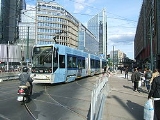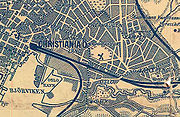
Gamleby Line
Encyclopedia
The Gamlebyen Line is a section of the Oslo Tramway which runs east from Jernbanetorget
along Schweigaards gate (street), past the Oslo Bus Terminal
then turns south along Oslo gate, and past Gamlebyen before becoming the Ekeberg Line
. The section is served by lines 18 and 19.
in 1875 as a horsecar
route between Stortorvet and Gamlebyen. In 1900 the line was electrified, and received branch lines to Kampen and Vålerenga. The Vålerenga Line was extended to Etterstad in 1923, where there was a transfer to the Østensjø Line. Until 1925, the line was named the Oslo Line; with the name change of the city from Kristiania to Oslo, the district known as Oslo was renamed Gamlebyen.
The plans from 1919 called for a common connection from the Østensjø Line and the Ekeberg Line to the city center, along with the proposed Lambertseter Line. The Ekberg Line was to run through a tunnel from Sjømannskolen
to Lodalen, from there over a bridge and then connect with the Østensjø Line at Harald Hårdrådes plass. They would then run along an elevated line along Schweigaards gate to Vaterland
, and from there in a tunnel to a terminus at Stortorvet
.
In 1937, Ekebergbanen proposed a line south of Oslo gate on a bridge over Kongsveien, Oslo gate and the railway tracks, and then along Kanslergata to the proposed elevated line in Hollendergata. A formal concession was sent in 1937, but the plans were stopped by the war. After the war, it was decided that the Lambertseter Line would run from Bryn on the Østensjø Line, which would allow the Lambertseter Line, which had been proposed to connect to the Ekeberg Line, to become part of the metro. This terminated plans for rebuild the downtown section of the Ekeberg Line.
In 1957, a new route from Oslo gate via Schweigaards gate to Jernbanetorget was built to reduce travel time along the new Lambertseter Line. In 1966, the Østensjø and Lambertseter Lines were transferred to the Oslo Metro.
In the 1970s, the traffic from Mosseveien was rerouted over Loenga Bridge into Bispegata. Oslo gate was then closed for through traffic, which improved traffic. The section from Jernbanetorget to Hollendergata was rebuilt between 1988 and 1991, resulting in an all-new light rail section in its own right-of-way. The rest of the line was renovated from 1990 to 1992.
There are plans to move the line from Schewigaards gate and let the line run through Dronning Eufemias gate as part of the development in Bjørvika
. The move is expected to be done in 2014.

Jernbanetorget (station)
Jernbanetorget is both a rapid transit station on the Oslo Metro and a light rail station of the Oslo Tramway. The metro station is in the Common Tunnel used by all lines under the city centre. It is located between Stortinget to the west and Grønland to the east. Until the construction of the...
along Schweigaards gate (street), past the Oslo Bus Terminal
Oslo Bus Terminal
Oslo Bus Terminal is the main bus station serving Oslo, Norway. Owned by Vaterland AS it is located beside Oslo Central Station and serves local buses to Akershus as well as domestic and international coaches.-Service:...
then turns south along Oslo gate, and past Gamlebyen before becoming the Ekeberg Line
Ekeberg Line
The Ekeberg Line is a long light rail line of the Oslo Tramway which runs from Gamlebyen to Ljabru in Oslo, Norway. Operated by lines 18 and 19, it serves the area of Nordstarand and the neighborhoods of Ekeberg, Jomfrubråten, Bekkelaget and Ljan. The line is operated by Oslo Sporvognsdrift using...
. The section is served by lines 18 and 19.
History
The line was opened by Kristiania SporveisselskabKristiania Sporveisselskab
AS Kristiania Sporveisselskab or KSS, nicknamed the Green Tram , was the first tram operator in Oslo, Norway. Founded in 1874, it started operation of horsecar services the following year and electric tram services in 1899...
in 1875 as a horsecar
Horsecar
A horsecar or horse-drawn tram is an animal-powered streetcar or tram.These early forms of public transport developed out of industrial haulage routes that had long been in existence, and from the omnibus routes that first ran on public streets in the 1820s, using the newly improved iron or steel...
route between Stortorvet and Gamlebyen. In 1900 the line was electrified, and received branch lines to Kampen and Vålerenga. The Vålerenga Line was extended to Etterstad in 1923, where there was a transfer to the Østensjø Line. Until 1925, the line was named the Oslo Line; with the name change of the city from Kristiania to Oslo, the district known as Oslo was renamed Gamlebyen.
The plans from 1919 called for a common connection from the Østensjø Line and the Ekeberg Line to the city center, along with the proposed Lambertseter Line. The Ekberg Line was to run through a tunnel from Sjømannskolen
Sjømannsskolen (station)
Sjømannsskolen is a light rail station on the Ekeberg Line of the Oslo Tramway. It is located near Sjømannsskolen in Ekeberg, in the borough of Nordstrand, in Oslo, Norway....
to Lodalen, from there over a bridge and then connect with the Østensjø Line at Harald Hårdrådes plass. They would then run along an elevated line along Schweigaards gate to Vaterland
Vaterland, Norway
Vaterland is a neighborhood in Oslo, Norway. It is located north of the tracks at Oslo Central Station, between Jernbanetorget, Storgata and Akerselva river. The area features Oslo Central Station and Oslo Bus Terminal, the shopping centers Oslo City and Byporten, Galleri Oslo, Radisson Blu Plaza...
, and from there in a tunnel to a terminus at Stortorvet
Stortorvet (station)
Stortorvet is a station on the Oslo Tramway in Oslo, Norway. The station is located on the square Stortorvet in the city centre.It is served by the lines 11, 17 and 18. In 2009, it was decided to improve the square, the station and the tram tracks in the street.-References:...
.
In 1937, Ekebergbanen proposed a line south of Oslo gate on a bridge over Kongsveien, Oslo gate and the railway tracks, and then along Kanslergata to the proposed elevated line in Hollendergata. A formal concession was sent in 1937, but the plans were stopped by the war. After the war, it was decided that the Lambertseter Line would run from Bryn on the Østensjø Line, which would allow the Lambertseter Line, which had been proposed to connect to the Ekeberg Line, to become part of the metro. This terminated plans for rebuild the downtown section of the Ekeberg Line.
In 1957, a new route from Oslo gate via Schweigaards gate to Jernbanetorget was built to reduce travel time along the new Lambertseter Line. In 1966, the Østensjø and Lambertseter Lines were transferred to the Oslo Metro.
In the 1970s, the traffic from Mosseveien was rerouted over Loenga Bridge into Bispegata. Oslo gate was then closed for through traffic, which improved traffic. The section from Jernbanetorget to Hollendergata was rebuilt between 1988 and 1991, resulting in an all-new light rail section in its own right-of-way. The rest of the line was renovated from 1990 to 1992.
There are plans to move the line from Schewigaards gate and let the line run through Dronning Eufemias gate as part of the development in Bjørvika
Bjørvika
Bjørvika is a neighborhood in the Sentrum borough of Oslo, Norway. The area is an inlet in the inner Oslofjord, situated between Gamlebyen and Akersness. It serves as an outlet for the river Akerselva. Since the 2000s, it has been undergoing urban redevelopment, being transformed from a container...
. The move is expected to be done in 2014.


